As small business owner working in the research and development area, it is vital for me to keep expanding my capabilities and refining the portfolio of what I can offer to clients. Although I already have a wide range of UV, visible light and IR imaging equipment, along with UV and visible spectroscopy capability (Ocean Insight FX spectrometer), which I use for looking at lens and filter transmission, IR transmission spectroscopy is an area which I am currently lacking. Given the financial upheavals of the last 12 months, the decision to invest in a new piece of kit is not made lightly and new kit must fill a gap in my measurement ability.
My spectroscopy interest is driven mainly by my photography. Camera sensors are mainly sensitive between about 300nm and 1200nm, so this is my area of interest. My Ocean Insight FX spectrometer covers my needs from 250nm to 800nm, and I’ve been very happy with that over the years. Going above 800nm is something I’ve been thinking about for a while, as understanding the behavior of filters for UV photography in the IR is very important – even small leaks in the IR region can be a huge problem for UV imaging. In an ideal world I’d like a spectrometer that would be good for up to and just above 1200nm, however that is a bit of an issue as standard solid state spectrometers tend to only be good up to about 1100nm. Above that you tend to get into more exotic sensors such as InGaAs (indium gallium arsenide) and the costs go up very quickly. As a compromise then, I decided to look at the IR ones with conventional sensors and able to measure up to 1100nm. Between 1100nm and 1200nm the camera sensitivity is dropping rapidly, so this is a compromise I am willing to accept for now.
I do a lot of my research from home and my workshop space is limited. As a result of that I tend to look for compact equipment. Combining sensitivity from around 700nm to 1100nm with small size of equipment led me to the Ocean Insight STS-NIR spectrometer and I’ve been fortunate enough to get one of these to evaluate. Initially I was a little skeptical as to whether such a small spectrometer would give good results. And when I say small, I mean small. Here it is in the flesh, next to a 2p coin.
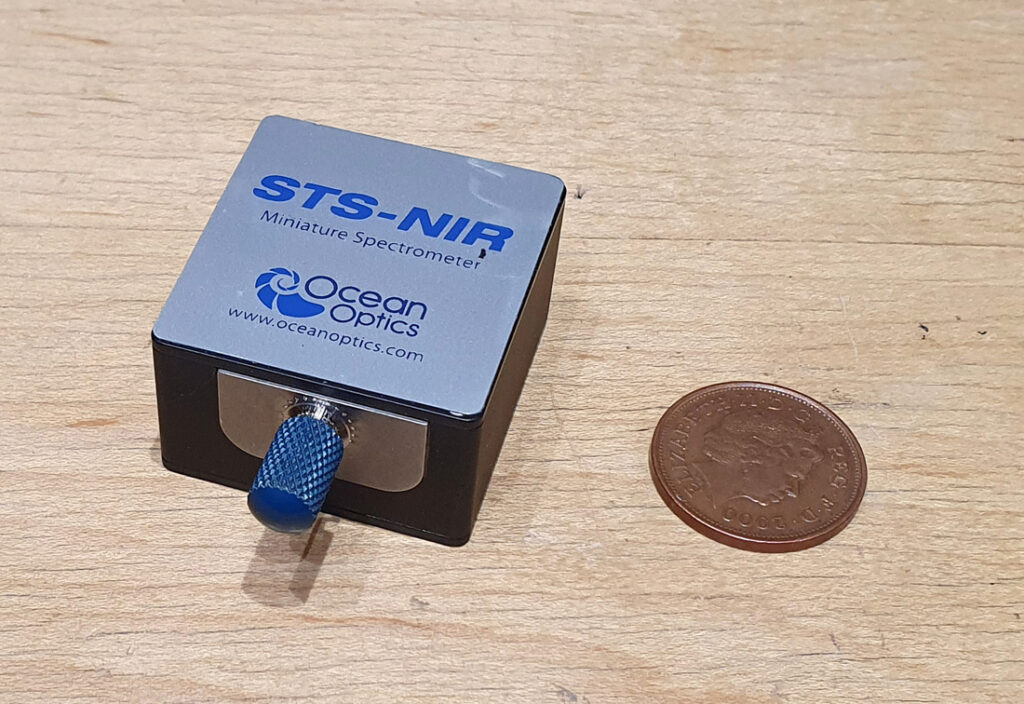
This spectrometer is tiny – 40x42x24mm – with a fiber optic connector at the front, and a USB socket at the rear. Could this really give good data from 650nm to 1100nm?
As a first test I decided to look at a range of IR photographic filters – Heliopan 715, 780, 830 and 1000 – which I use for IR imaging. Light source wise I used my Ocean Insight DH-2000-BAL and set everything up for transmission measurement. Here’s how the filters look.
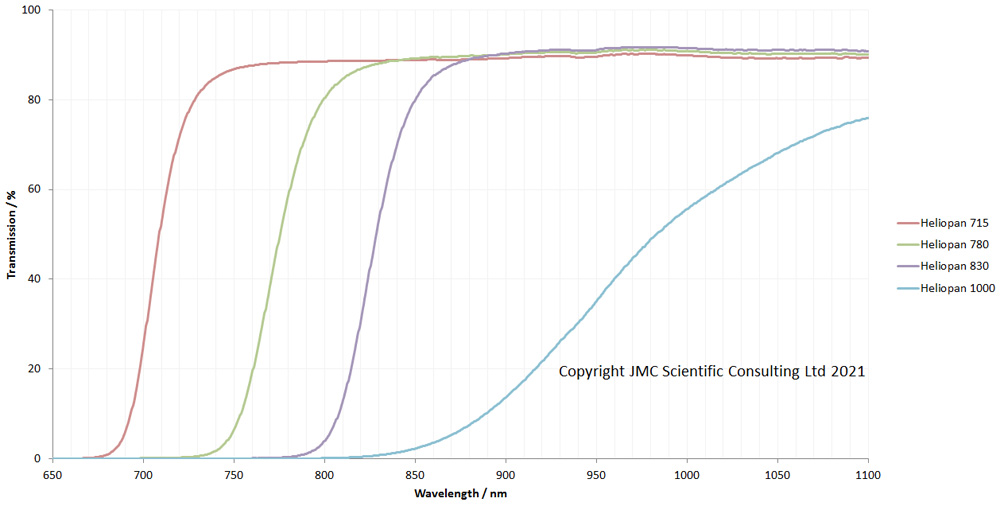
Well, that was pretty impressive for an initial test. The filter transmission curves were as expected and very clean. Up in the 1000 to 1100nm region, the data get a little more noisy, but the sensor is losing a bit of sensitivity up there and the light source is dropping in intensity as well.
As a next test I took some of my Hoya U-340 filters (from UVIRoptics), and started stacking them up on top of each other. Hoya U-340 is a bandpass filter which has good UV transmission, but does have an IR leak at around 725nm. Using a combination of 2mm and 4mm thick ones I measured the transmission of 4mm, 6mm (4mm+2mm), and 8mm (4mm+4mm) between 650 and 1100nm.
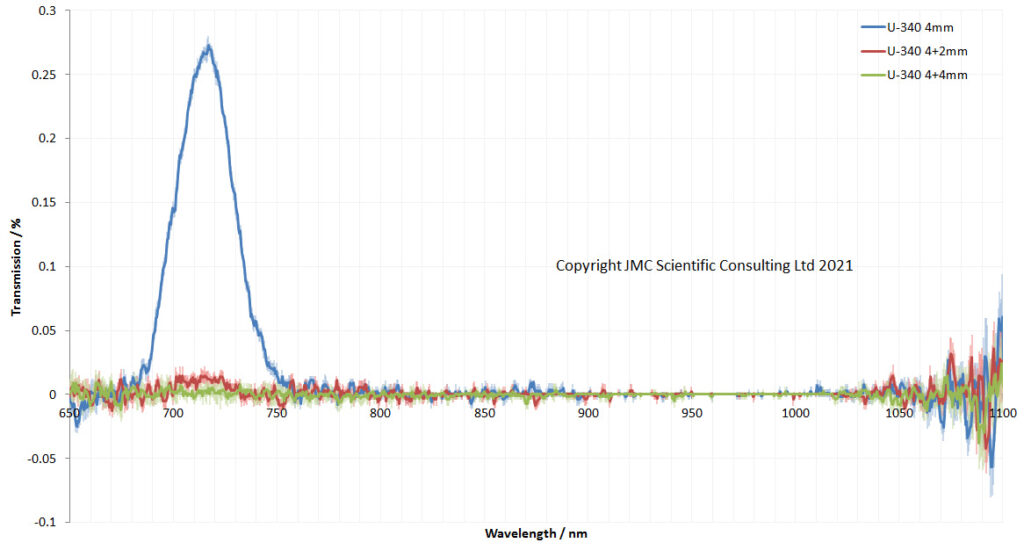
Each of the lines above was the average of 10 individual runs, and the standard deviations of the scans are shown as paler coloured error bars on either side of the lines. As expected the 4mm Hoya U-340 showed an IR leak of about 0.25% at around 725nm. This leak was nice and clean with the STS-NIR. Above about 1020nm the data for all three filters gets a bit noisy – as mentioned above the sensitivity of the sensor is low up there at the extreme top end, and the light source intensity drops too, so I’m not surprised to see that.
How about if we zoom in to the the 725nm and look in a bit more detail?
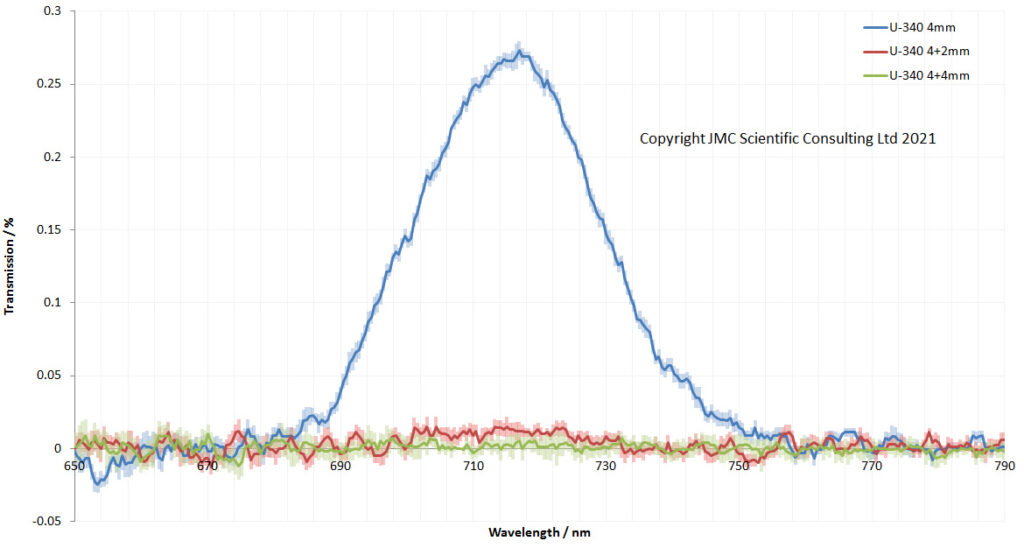
The standard deviation error bars can be seen more cleanly like this and it shows very good reproducibility. The leak in the 6mm stack looks to still be visible and different to the 8mm stack. This can be seen more clearly by zooming in yet again.
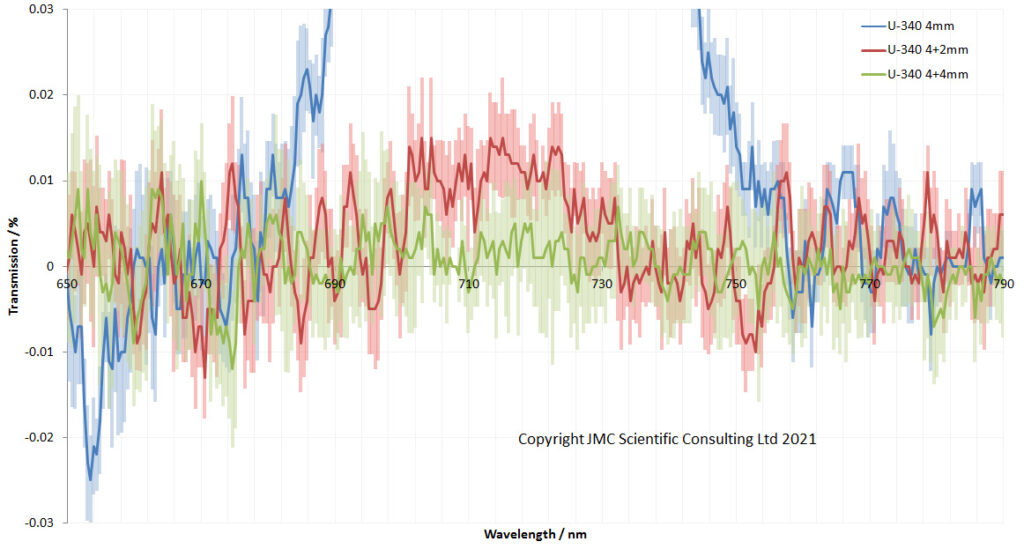
At this scale, the leak in the 6mm stack at 725nm can still be seen, as about 0.01% (this equates to Optical Density OD4 blocking of the IR). By the time you get to 8mm thick, the leak can no longer be seen due to the extra thickness of the filter stack. So, again, very impressive result from the little STS-NIR microspectrometer.
What have a learned so far? I’ve been very surprised and impressed by the Ocean Insight STS-NIR. For such a small spectrometer it gives very good results. It’s proved that it is capable for assessing filters, and I hope to try it for looking at lens transmission too, although this will be a bigger challenge for it (and my light sources). In theory with the lights I have I should be able to measure lens transmission between 280nm and 1100nm using the FX and STS-NIR spectrometers, which will cover most of the area that normal camera sensors are sensitive too.
Thanks for reading and I hope you enjoyed my latest foray in the measurement world. If you’d like to know more about this or any other aspect of my work, you can reach me here.
